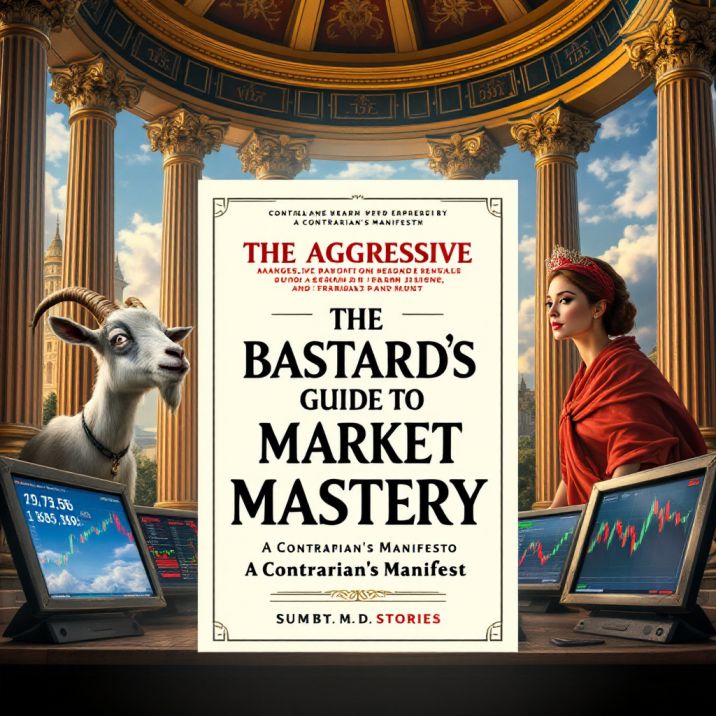
Market Complacency: A Path to Pain and Loss—Steps to Overcome It
Nov 26, 2024
The Illusion of Perpetual Prosperity
Citizens of the financial world, lend me your ears! We stand on the precipice of a profound reckoning, yet many walk with eyes wide shut, entranced by the mirage of endless growth. Market complacency is the silent thief of fortune, creeping into the hearts of investors who mistake a bull run for an eternal state. This complacency, this dangerous illusion of perpetual prosperity, sows the seeds of pain, loss, and misery.
Recall the tales of old when traders laden with riches believed the tides of fortune would forever favour them. They danced to the melody of rising markets, oblivious to the looming storm. History whispers warnings from the shadows, yet the intoxication of gains renders us deaf. Just as the ancient mariners disregarded storm clouds on the horizon, so do modern investors ignore the telltale signs of an impending market crash.
Historical Precedents and Modern Echoes
The cycles of human folly repeat with uncanny precision. In the early 17th century, the Dutch Tulip Mania gripped Holland. Ordinary bulbs soared to extraordinary prices, with some specimens costing more than grand homes on the Amsterdam canals. The masses, blinded by greed, bought tulips not for their beauty but for the promise of quick profit. When the bubble burst, fortunes evaporated overnight, and despair blanketed the land.
Fast forward to the 21st century. The 2008 financial crisis echoed these patterns. Mortgage-backed securities, complex derivatives, and unchecked lending practices created an illusion of unending wealth. Complacency blinded institutions and individuals alike. A revered investor once remarked that “only when the tide goes out do you discover who’s been swimming naked.” When the financial tsunami hit, it exposed the frailty beneath the surface.
The Perils of Ignoring Warnings
Throughout history, wise voices have cautioned against the dangers of complacency. An ancient advisor counselled, “Do not be arrogant because of your knowledge; heed the counsel of the humble”. Yet arrogance prevails when markets soar. Investors dismiss warnings as the pessimism of naysayers, embracing narratives that justify inflated valuations.
In the dot-com bubble of the late 1990s, technology stocks skyrocketed despite many companies lacking viable business models. The absurd belief that profits were irrelevant in the new economy led to catastrophic losses. A seasoned market strategist highlighted that “the four most dangerous words in investing are: ‘This time it’s different.'” The following crash was a harsh reminder that fundamentals cannot be ignored.
The Mathematics of Loss and Recovery
Let us confront an unforgiving truth: losses disproportionately impact wealth. A 50% loss requires a 100% gain to break even. This is not a theoretical exercise but a painful reality for many. During the Great Recession, global markets plummeted, erasing trillions in wealth. Those who remained complacent suffered the most, clinging to the hope that markets would self-correct swiftly.
Consider an investor with a portfolio worth $1 million who experiences a 40% loss, reducing the value to $600,000. To recover the original $1 million, a subsequent gain of approximately 67% is required, not merely 40%. This harsh arithmetic underscores the peril of complacency and the importance of proactive measures to safeguard assets.
Strategies to Capitalize on Market Downturns
But despair is not, for within every crisis lies the seed of opportunity. The astute investor perceives market crashes not as misfortunes but as avenues for substantial profit. One effective approach is selling put options in the aftermath of a crash. When markets tumble, volatility spikes, and option premiums soar. Investors collect significant premiums by selling put options on quality stocks at strike prices below current levels.
For example, suppose after a market decline, a blue-chip stock trades at $50, down from $75. An investor sells put options with a strike price of $45, expiring in six months, receiving a premium of $5 per share. If the stock remains above $45, the investor keeps the premium. If it falls below, the investor effectively purchases the stock at an adjusted price of $40 ($45 strike price minus $5 premium), owning a valuable asset at a significant discount.
With the premium earned from selling puts, the investor can purchase call options on oversold stocks or indices, positioning for gains as the market recovers. This strategy leverages fear-induced premiums to build wealth, embodying the principle of “being greedy when others are fearful.”
Embracing Contrarian Wisdom
Success in turbulent markets often requires a contrarian mindset. When the herd panics, opportunities abound for those who remain rational. An ancient sage advised, “Advance your wisdom by seeking that which escapes common sight”. Practically, this means looking beyond the prevailing sentiment to identify intrinsic value.
During the 1987 stock market crash, while panic led many to liquidate holdings, a renowned investor began buying aggressively. His rationale was simple: the fundamentals of quality companies remained strong despite the market’s irrational behaviour. His actions, rooted in independent analysis rather than herd mentality, resulted in substantial long-term gains.
Cultivating Emotional Discipline
Emotional discipline is the linchpin of successful investing. Markets are arenas of human psychology as much as economics. Fear and greed drive cycles more powerfully than data or logic. Recognizing and controlling one’s emotional responses is paramount.
A contemporary investment philosopher emphasizes the importance of a stoic approach: “The investor’s chief problem—and even his worst enemy—is likely to be himself.” By establishing and adhering to a well-defined plan, investors can mitigate impulsive decisions driven by short-term market movements.
Practical Measures to Guard Against Complacency
To fortify oneself against the siren song of complacency, consider these actionable steps:
- Regular Portfolio Review: Assess asset allocation and adjust to maintain a balance aligned with risk tolerance and financial goals. Rebalancing can lock in gains and reduce exposure to overvalued sectors.
- Stress Testing Scenarios: Evaluate how your investments would perform under adverse conditions. Ask, “What if the market drops by 30%?” Preparing for worst-case scenarios enhances readiness.
- Continuous Education: Stay informed about market dynamics, economic indicators, and global events. Knowledge fortifies confidence and decision-making.
- Setting Stop-Loss Orders: Implement stop-loss orders to automatically sell positions if they decline beyond a predetermined point, limiting potential losses.
- Diversification: Spread investments across various asset classes, industries, and geographies. Diversification reduces the impact of a decline in any single area.
Learning from Exemplary Investors
Throughout history, those who have weathered market storms exhibit common traits: diligence, patience, and contrarian thinking. In the aftermath of the 2000 dot-com crash, a seasoned value investor avoided the inflated tech sector, instead focusing on traditional industries with solid fundamentals. While criticized during the boom, his portfolio outperformed significantly when the bubble burst.
An ancient proverb teaches, “Patience is the key to joy; haste is the key to sorrow”. Applying patience to investing means resisting the urge to chase trends and focusing on long-term objectives.
The Imperative of Preparedness
Preparedness is not merely a defensive posture but a proactive strategy. Building cash reserves allows investors to seize opportunities when assets are undervalued. During the 2020 market downturn sparked by a global health crisis, those with liquidity could acquire high-quality stocks at significant discounts.
Furthermore, establishing a clear investment thesis grounded in fundamental analysis guides volatility. Understanding why you own each asset helps maintain conviction when prices fluctuate.
Transforming Adversity into Advantage
Adversity, while challenging, catalyzes innovation and resilience. Market downturns force a reevaluation of strategies, exposing weaknesses and prompting improvement. By embracing this process, investors can emerge stronger.
A notable contemporary example is the shift towards companies with robust digital infrastructures during disruption—investors who recognized the accelerating trends towards technology and adaptability positioned themselves for substantial gains.
Conclusion: Mastery Through Wisdom and Action
In conclusion, let us acknowledge that markets are erratic, but our responses need not be. Complacency is a choice—a relinquishment of vigilance in favour of comfort. To avoid the ensuing pain, loss, and misery, we must choose wisdom over ease and action over inaction.
Market crashes, those moments of maximum fear and uncertainty, are nature’s gift to the prepared investor. When others see the devastation, the wise see opportunity. When the masses flee in panic, selling valuable assets at fire-sale prices, the prepared investor steps forward with confidence, ready to acquire quality at a discount. This is not mere opportunism—it is the natural law of markets at work.
Consider that every significant crash in history has eventually led to new heights. The 1929 crash, the 1987 decline, the 2000 dot-com bubble, the 2008 financial crisis, and the 2020 pandemic plunge—all these moments of apparent disaster became launching pads for extraordinary wealth creation for those who were prepared. The key lies not in predicting when crashes will occur but in being ready when they do.
Preparation takes many forms: maintaining cash reserves, studying market history, developing analytical skills, and, most importantly, building the emotional fortitude to act when others are paralyzed by fear. This is how generational wealth is built—not through the comfortable times of bull markets but through the crucible of crisis.
Heed the counsel passed down through generations: prosperity is cyclical, and fortune favours the prepared mind. By learning from the past, applying disciplined strategies, and maintaining emotional equilibrium, we safeguard our wealth and position ourselves to multiply it when others see only darkness.
Let us cast aside complacency and embrace prudent scepticism. Navigate the financial seas not with fear of storms but with the confidence that comes from knowing that every market crash carries the seeds of unprecedented opportunity within it. Ultimately, not the market determines our financial destiny but our preparation, courage, and wisdom in facing its challenges.
The time to prepare is now, while markets are calm. Build your knowledge, strengthen your resolve, and ready your resources. When the next crash comes—and it will come—you will not be among those who lament their losses but among those who seize the opportunity to build lasting wealth from the ashes of others’ complacency.
Wisdom’s Compass: Finding Direction in Thoughtful Discourse













